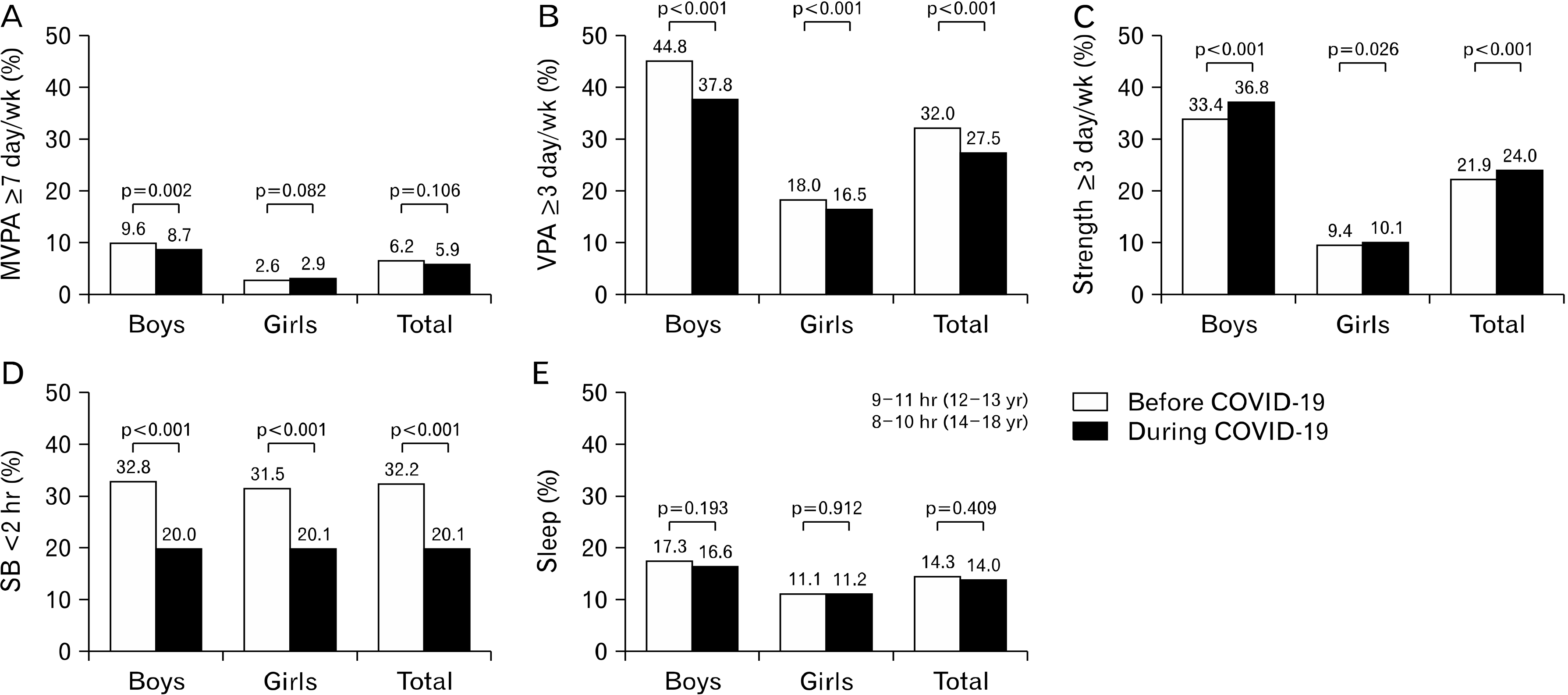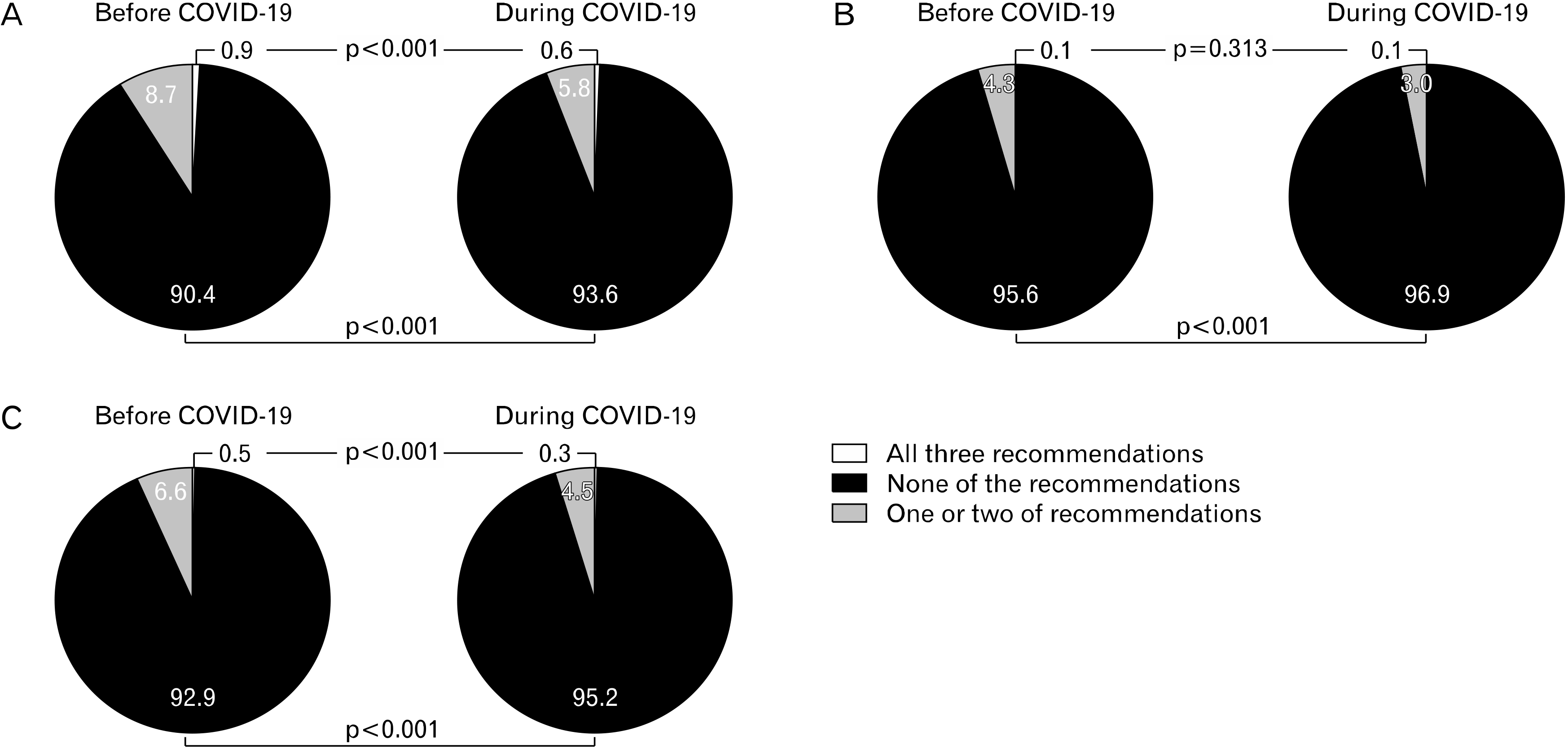1. Pan A, Liu L, Wang C, et al. 2020; Association of public health interventions with the epidemiology of the COVID-19 outbreak in Wuhan, China. JAMA. 323:1915–23. DOI:
10.1001/jama.2020.6130. PMID:
32275295. PMCID:
PMC7149375.

3. World Health Organization (WHO). 2022. Coronavirus (COVID-19) dashboard [Internet]. WHO;Geneva: Available from:
https://covid19.who.int. cited 2022 Apr 9.
5. Xiang M, Zhang Z, Kuwahara K. 2020; Impact of COVID-19 pandemic on children and adolescents' lifestyle behavior larger than expected. Prog Cardiovasc Dis. 63:531–2. DOI:
10.1016/j.pcad.2020.04.013. PMID:
32360513. PMCID:
PMC7190470.

6. Chen ST, Liu Y, Tremblay MS, et al. 2021; Meeting 24-h movement guidelines: prevalence, correlates, and the relationships with overweight and obesity among Chinese children and adolescents. J Sport Health Sci. 10:349–59. DOI:
10.1016/j.jshs.2020.07.002. PMID:
32679341. PMCID:
PMC8167320.

7. World Health Organization (WHO). 2020. WHO guidelines on physical activity and sedentary behavior: at a glance glance [Internet]. License: CC BY-NC-SA 3.0 IGO. WHO;Geneva: Available from:
https://apps.who.int/iris/handle/10665/337001. cited 2022 Apr 9.
8. Tremblay MS, Carson V, Chaput JP, et al. 2016; Canadian 24-hour movement guidelines for children and youth: an integration of physical activity, sedentary behaviour, and sleep. Appl Physiol Nutr Metab. 41(6 Suppl 3):S311–27. DOI:
10.1139/apnm-2016-0203. PMID:
27306430.
9. Aubert S, Barnes JD, Abdeta C, et al. 2018; Global Matrix 3.0 Physical Activity Report Card grades for children and youth: results and analysis from 49 countries. J Phys Act Health. 15(S2):S251–73.
10. Yang S, Jang J, Park SY, et al. 2022; Two-year report of COVID-19 outbreak from January 20, 2020 to January 19, 2022 in the Republic of Korea. Public Health Wkly Rep. 15:422–6.
11. Ministry of Education. Ministry of Health and Welfare. Korea Disease Control and Prevention Agency. The 15th Korea Youth Risk Behavior Survey, 2019. Korea Disease Control and Prevention Agency;Daejeon, Korea: 2019.
12. Ministry of Education. Ministry of Health and Welfare. Korea Disease Control and Prevention Agency. The 16th Korea Youth Risk Behavior Survey, 2020. Korea Disease Control and Prevention Agency;Daejeon, Korea: 2020.
13. Rey-López JP, Vicente-Rodríguez G, Biosca M, Moreno LA. 2008; Sedentary behaviour and obesity development in children and adolescents. Nutr Metab Cardiovasc Dis. 18:242–51. DOI:
10.1016/j.numecd.2007.07.008.

14. Hoare E, Milton K, Foster C, Allender S. 2016; The associations between sedentary behaviour and mental health among adolescents: a systematic review. Int J Behav Nutr Phys Act. 13:108. DOI:
10.1186/s12966-016-0432-4. PMID:
27717387. PMCID:
PMC5055671.

15. Tremblay MS, LeBlanc AG, Kho ME, et al. 2011; Systematic review of sedentary behaviour and health indicators in school-aged children and youth. Int J Behav Nutr Phys Act. 8:98. DOI:
10.1186/1479-5868-8-98. PMID:
21936895. PMCID:
PMC3186735.

16. Mitchell JA, Rodriguez D, Schmitz KH, Audrain-McGovern J. 2013; Greater screen time is associated with adolescent obesity: a longitudinal study of the BMI distribution from ages 14 to 18. Obesity (Silver Spring). 21:572–5. DOI:
10.1002/oby.20157. PMID:
23592665. PMCID:
PMC3630469.

17. Olson JA, Sandra DA, >Colucci ÉS, et al. 2022; Smartphone addiction is increasing across the world: a meta-analysis of 24 countries. Comput Human Behav. 129:107138. DOI:
10.1016/j.chb.2021.107138.

19. Matricciani L, Olds T, Williams M. 2011; A review of evidence for the claim that children are sleeping less than in the past. Sleep. 34:651–9. DOI:
10.1093/sleep/34.5.651. PMID:
21532959. PMCID:
PMC3079945.

20. Ahn CY, Kim EY, Hong JY, Kim HS, Lee MS. 2017; Related factors of sleep quality among some middle and high school students. J Korean Soc Sch Community Health Educ. 18:43–56.
21. Kredlow MA, Capozzoli MC, Hearon BA, Calkins AW, Otto MW. 2015; The effects of physical activity on sleep: a meta- analytic review. J Behav Med. 38:427–49. DOI:
10.1007/s10865-015-9617-6. PMID:
25596964.

22. Oh JW, Lee EY, Lim J, et al. 2019; Results from South Korea's 2018 Report Card on physical activity for children and youth. J Exerc Sci Fit. 17:26–33. DOI:
10.1016/j.jesf.2018.10.006. PMID:
30662511. PMCID:
PMC6323304.

23. Ricardo LI, Wendt A, Costa CD, et al. 2022; Gender inequalities in physical activity among adolescents from 64 Global South countries. J Sport Health Sci. 11:509–20. DOI:
10.1016/j.jshs.2022.01.007. PMID:
35074485. PMCID:
PMC9338337.

24. Lee G. 2021; Analysis of the characteristics of moderate to vigorous physical activity of middle school adolescents according to gender and number of school physical activity in COVID-19. Korean J Sport Pedagog. 28:67–80. DOI:
10.21812/kjsp.2021.10.28.4.67.

25. Bates LC, Zieff G, Stanford K, et al. 2020; COVID-19 impact on behaviors across the 24-hour day in children and adolescents: physical activity, sedentary behavior, and sleep. Children (Basel). 7:138. DOI:
10.3390/children7090138. PMID:
32947805. PMCID:
PMC7552759.

26. Tan ST, Tan CX, Tan SS. 2021; Physical activity, sedentary behavior, and weight status of university students during the COVID-19 lockdown: a cross-national comparative study. Int J Environ Res Public Health. 18:7125. DOI:
10.3390/ijerph18137125. PMID:
34281062. PMCID:
PMC8297249.

27. Paterson DC, Ramage K, Moore SA, Riazi N, Tremblay MS, Faulkner G. 2021; Exploring the impact of COVID-19 on the movement behaviors of children and youth: a scoping review of evidence after the first year. J Sport Health Sci. 10:675–89. DOI:
10.1016/j.jshs.2021.07.001. PMID:
34237456. PMCID:
PMC8687706.

29. Lee KC, Cho SM. 2014; The Korean national curriculum for physical education: a shift from edge to central subject. Phys Educ Sport Pedagog. 19:522–32. DOI:
10.1080/17408989.2014.915299.

30. Dubuc MM, Berrigan F, Goudreault M, Beaudoin S, Turcotte S. 2021; COVID-19 impact on adolescent 24 h movement behaviors. Int J Environ Res Public Health. 18:9256. DOI:
10.3390/ijerph18179256. PMID:
34501845. PMCID:
PMC8431636.








 PDF
PDF Citation
Citation Print
Print



 XML Download
XML Download